It was several years ago while at Bannerghatta Nature Camp in Bangalore, when I was waiting for my transport that I first saw a mud dauber wasp visiting a damp patch on the ground. As I watched it, I realized that it was gathering the wet mud into a tiny little blob and before I could realize, it flew away, carrying the ball. I was amazed at the ease and speed with which it went about the whole act. All this while, I had not realized that my camera was in the bag right next to me. It suddenly dawned on me that I had missed an opportunity to document this behaviour. However, even while all this was going on in my head, the wasp reappeared. And yes, you guessed it right – I did photograph a mud dauber wasp (Sceliphron sp.; Family Sphecidae) in the act of collecting soil to build its nest after all!
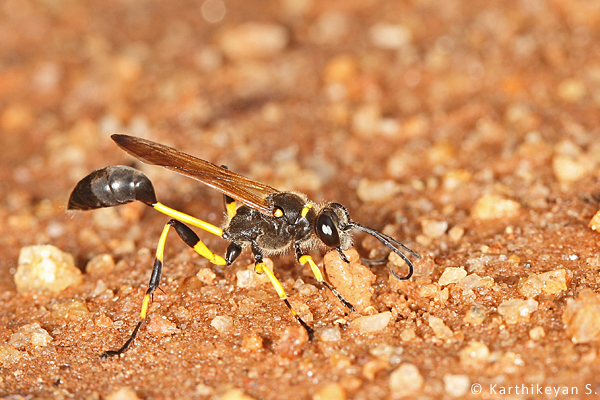
The Black and Yellow Mud Dauber Wasp gathering wet mud to build earthern receptacles. Sceliphron sp. Fam : Sphecidae
The wasp being so small was not very helpful – I could not follow it to the location where it was building the nest. So, photographing the nest building itself had to wait for another time.
That opportunity could not have come at a more appropriate time. One morning, about a week into the country’s lockdown (when we stayed indoors to contain the spread of the Covid Virus), I settled on the sofa with a book in one hand and a mug of black coffee in the other. Somewhere between this moment and before beginning to read, I noticed something odd on the window frame. I went close and realized that it was a wasp’s nest. The wasp floored me by her choice of the nest’s location. It was sheltered from direct sun, rain and even the jet of water from the hose that the gardener directs in that general direction day after day! Quickly, the excitement of this discovery and the smile on my face disappeared – the nest was complete and the mouth sealed! So, did things have to wait again for the next opportunity?
Even as these thoughts were streaming in my head, I espied the wasp approaching the nest. I quickly moved back so as not to scare the tiny wasp that had decided to use the safety of the window frame of my house. The black and yellow wasp with a long slender waist flew in and landed on the frame. I was getting curious now…
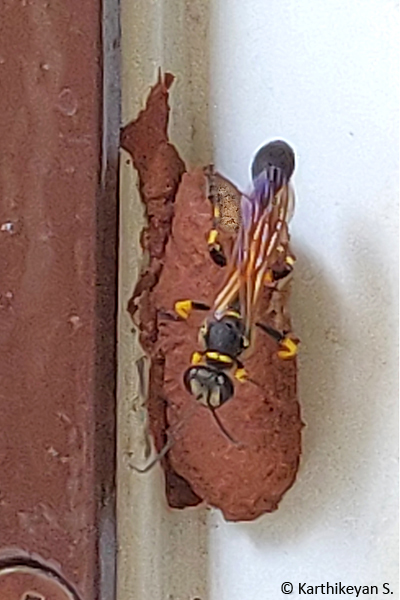
Mud Dauber sitting on the earthern pot it has built.
Without wasting time, she walked up to the pot, walked all over as if to examine it and then went on to doing something completely unexpected. She used her mandibles to cut through the mud seal and in no time opened the mouth of the pot – this came as a complete surprise!
Did the nest belong to this wasp? If yes, why was she opening it up? Alternatively, did it belong to another wasp? Was she going to destroy it? Was she going to take away the paralyzed prey that lay inside? (Read Parental care in Wasps) All these questions raced through my mind as the wasp flew away after opening up the mouth of the mud structure and I picked up my book again and started to read, constantly keeping an eye on the nest.
Some time elapsed – about an hour or so – and the mud dauber reappeared. As she settled on the window frame, I realized that she was carrying something between her mandibles – it was a spider! Quickly shoving it inside the pot, she came out and spent some time restlessly looking around before flying away.
Now the adult black and yellow mud dauber wasp (Sceliphron sp.) primarily feeds on flower nectar. The effort she puts in to bring in spiders after paralyzing them as provision for the young wasp is incredible. Not just that, the spiders she brings in could easily weigh much more than her own weight. Similarly, each blob of mud could weigh as much or more than her body weight. To be able to fly long distances with a heavy payload is no easy task. Also, being able to locate spiders is another capability in itself.
Our friend came back almost an hour later – this time again with a spider – and repeated the whole process. The next time around that she returned, she had with her, a blob of wet mud. This she used to make a lid for the pot. Two such trips and she had sealed the mouth of the pot. All this activity answered some of my questions. The nest belonged to the same individual after all and she opened it to stock more paralyzed spiders.
The next morning I decided to sit in the same place to keep a watch. My wife decided to give me company through this. I was curious to know what would happen next. Was the story over? No. Not really…the wasp reappeared! After a brief inspection, she opened the mouth of the pot again. This done, she went away. Over the next few hours, she returned thrice. She brought a spider each on the first two occasions. However, during the third visit it was not clear whether she brought in more limp spiders or just came back for a quick stocktaking. She put her head into the pot and packed the already existing prey before she flew away.
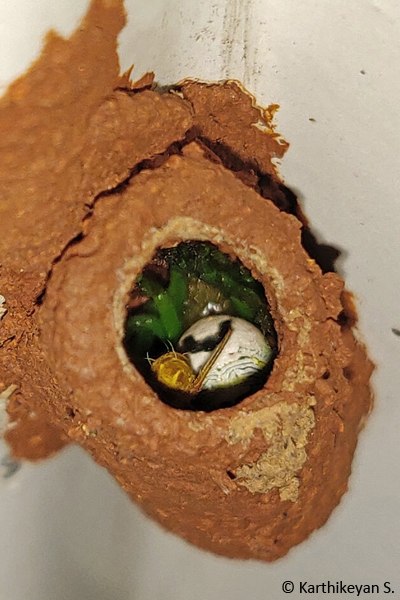
Paralyzed spiders inside the pot. Most spiders that were brought in belonged to the family Araenidae. Kidney Spider Araneus mitificus and Cyrtophora sp on one occasion each, with Neoscona sp. accounting for the rest.
And the next time she came back with a blob of mud and started sealing the entrance once again. Did she lay an egg as one would have expected her to when I was not watching? I could never tell. Curiosity got the better of us and we took a picture of the inside of the pot. An egg – the purpose of all her labour!
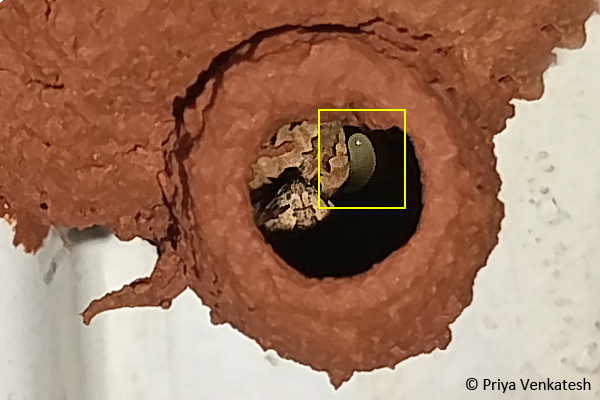
Wasp egg.
It took two trips and two blobs of mud to seal the entrance once again. Watch the following videos.
What she now went on to do after fully covering the entrance, was different from what had transpired the previous day. She added two more layers of mud to finish it off!
This done, she went on to bring in more mud to reinforce the sides of the mud structure. She made as many as 30 visits in a matter of just one hour, each time with a blob of mud! This averages to 2 min per visit. During each visit, she flew in with mud and plastered it at places that she felt required reinforcement. The nest I saw to be narrow and long had now completely changed its shape and appearance.
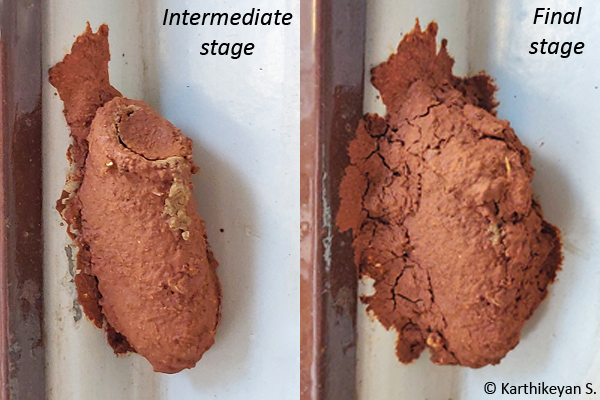
Comparison of the nest when we first saw it and when it was completed.
The story does not end here. Just when we thought the wasp had finally finished what she had started with, she began all over again!! She quickly set about building a second cell… and a third. Each time she went about building the cell with blobs of wet mud, finishing the structure, locating and paralyzing the spiders by stinging them, carrying them to the nest, putting them in, laying an egg, sealing the entrance, and adding more mud to reinforce.
Mud Dauber wasps typically lay one egg per cell and stock it with 3-4 spiders. At the time of finishing the story, this slender and frail looking mud dauber wasp was in the process of working on the third cell. This is industry at its best.
How many more she will go on to build will be known only with more vigil. We intend to stay cemented on the sofa and keep our eyes open in the coming days.
(I would like to thank Rana Belur for help with all the videos)
Update : Our curiosity and patience paid off. We were rewarded with the pleasure of watching the Mud dauber build and provide many more cells with spiders. She went on to build 9 cells in all.
Each of the first eight cells was opened by the next generation of mud daubers; we were able to witness only one individual emerging though. It took an average of 23 days from the time a cell was sealed to the time the young one emerged.
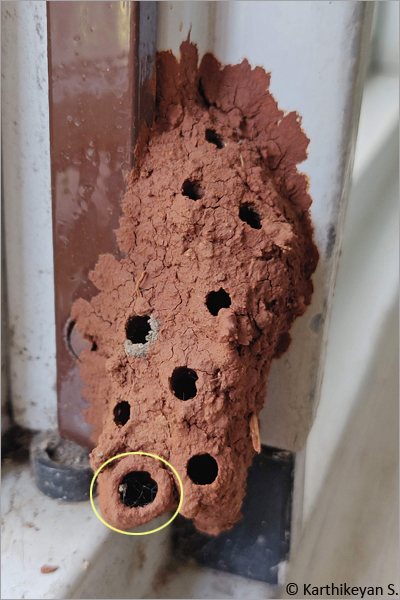
The cluster of mud dauber cells after all the young ones had emerged.
The 9th cell will remain a mystery. The Mud dauber diligently built it and even provisioned the last cell with paralysed spiders but for reasons that we will never know, she did not return to seal that cell. We never saw her ever again.